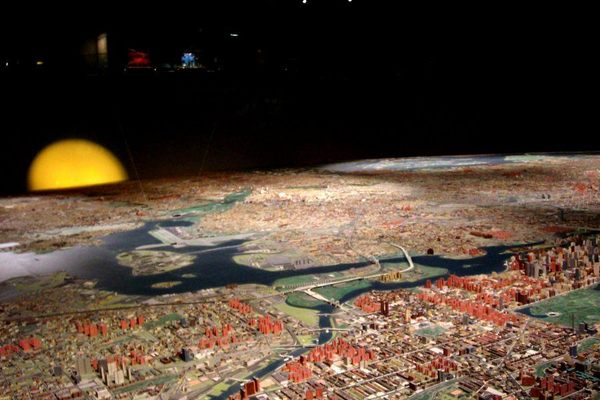Relics of the World’s Fair: Paris
Illustrated panorama of the 1900 Paris Exposition by Lucien Baylac (via Library of Congress)
Say “World’s Fair” and many think of grand culture shows that happened once in a great while, at some time in the past. However, these celebrations of artistic and technological achievement have been going on nearly every year since 1851, in scores of cities on five different continents. While most World’s Fair organizers opt for cheaper, temporary buildings, some permanent structures and monuments still exist from these grand events — so many, in fact, that we’re posting a series on the cities where the fairs most guided their character today.
Here we start with Paris, home of the most fairs — and one of the most-visited relics.
PARIS
Host to six fairs — 1855, 1867, 1878, 1889, 1900, and 1937
Photographic print of the Eiffel Tower in the 1900 Paris Exposition (via Brown University)
In addition to being Paris’ most famous landmark, the Eiffel Tower is less commonly known as a World’s Fair landmark.
The Eiffel Tower was the entrance arch to Paris’ 1889 “Exposition Universelle,” but the tower itself wasn’t quite finished by the fair’s opening day. A team of dedicated construction workers spent the entire night before finishing a second floor observation deck, so visitors could at least climb that far. Relatives of Gustave Eiffel, the tower’s architect, gratefully said of the workers that “no soldier on the battlefield deserved better mention than these humble toilers, who will never go down in history.”
View from the Eiffel Tower during the 1889 Exposition Universelle (via Wikimedia)
The greenspace surrounding the Eiffel Tower, the Champ de Mars, has a much longer history — one that stretches before the World’s Fair. It was a military parade ground first, in the mid-1700s. Then in the 1790s it was the site of the first Bastille Day celebration, and had also seen a particularly bloody battle during the French Revolution. Napoleon III chose the site for Paris’ second World’s Fair in 1867, and all subsequent Parisian fairs have taken place there.
View of the Champ de Mars from the Eiffel Tower in 1900 (via Brown University)
Champ de Mars today (photograph by Tambako the Jaguar/Flickr user)
Across the Seine is the Grand Palais, an exhibition hall built for the World’s Fair of 1900. The Grand Palais was a showcase for French art and cultural exhibits, and its design incorporated elements of the then-new Art Nouveau design movement. It was built on the site of a yet earlier exhibition hall — the Palais de l’Industrie —from the 1855 fair. Today, the Grand Palais’ west wing is home to a science museum — the Palais de la Découverte — while the east wing is an exhibition space for art, fashion, and other events.
The Grand Palais in 1900 (via Brown University)
The sculpture exhibition in the Grand Palais in 1900 (via Brown University Library)
The Grand Palais today (photograph by Jean-Pierre Dalbéra)
Finally, near the Grand Palais are the Jardins du Trocadéro, part of the fairgrounds for the 1878 and 1937 fairs. The 1878 Fair mainly used the space for the Palais du Trocadéro, a largely administrative hall that provided meeting space for various international organizations. But the 1937 fair renovated Trocadéro for more general exhibition space and fairgrounds, with the Palais de Chaillot — a pair of Art Deco exhibition halls located on the foundation of the old Palais du Trocadéro. Today, the Palais de Chaillot is home to France’s naval museum — the Musée national de la Marine — as well as the Musée de l’Homme, an ethnological museum. A theater space, the Théâtre national de Chaillot, is also on the site.
The Palais du Trocadéro (ca. 1890-1900) (via Library of Congress)
Trocadéro today (photograph by isamiga76/Flickr user)
One last, and lesser-known, relic from the 1937 fair rests far outside Paris. A stainless steel sculpture, “Rabochiy i Kolkhoznitsa” (“Worker and Kolkhoz Woman”), was originally mounted on the Soviet Union’s exhibition hall for the 1937 fair. The fair’s organizers had placed the Soviet hall directly across from the German hall, at a time when tension between the Soviets and Germany’s Third Reich were high. The Soviets’ representatives wanted to show up the Germans, and turned to sculptor Vera Mukhina to create an especially eye-catching monument for their own hall. The sculpture, depicting a man and woman each holding up a hammer and a sickle, was relocated to Moscow after the fair, and today sits on the grounds of Moscow’s All-Russia Exhibition Center.
The Soviet Union (right) and Third Reich (left) pavilions at Expo 1937 (via Wikimedia)
The statue in Russia today (photograph by Sylvain Kalache)
Here are more photographs from the Paris World’s Fairs:
Opening ceremony in 1900 (via Wikimedia)
The machine exhibition in 1889 (via Brown University Library)
A food exhibition hall in 1889 (via Brown University Library)
The Palace of Illusions in 1900 (via Brown University Library)
Hot air balloon races in 1900 (via Brown University Library)
A giant telescope on display in 1900 (via Wikimedia)
Inside the Grand Palais (via Bibliothèque de Toulouse)
Italian Pavilion in 1900 (via Brooklyn Museum)
The Esplanade des Invalides in 1900 (via Brooklyn Museum)
The Eiffel Tower in 1900 (via Library of Congress)
The grand entrance in 1900 (via Library of Congress)
Aerial view in 1900 (via Brooklyn Museum)
Panorama in a lithograph, as viewed from a hot air ballon at Tuileries (via Library of Congress)
The Palais de l’électricité and le Château d’eau in 1900 (via Wikimedia)
The 1900 World’s Fair at night (via Brooklyn Museum)
The World’s Fair in October 1900 (photograph by Eugène Trutat, via Museum of Toulouse)
Stay tuned for more relics of the World’s Fairs.










Follow us on Twitter to get the latest on the world's hidden wonders.
Like us on Facebook to get the latest on the world's hidden wonders.
Follow us on Twitter Like us on Facebook